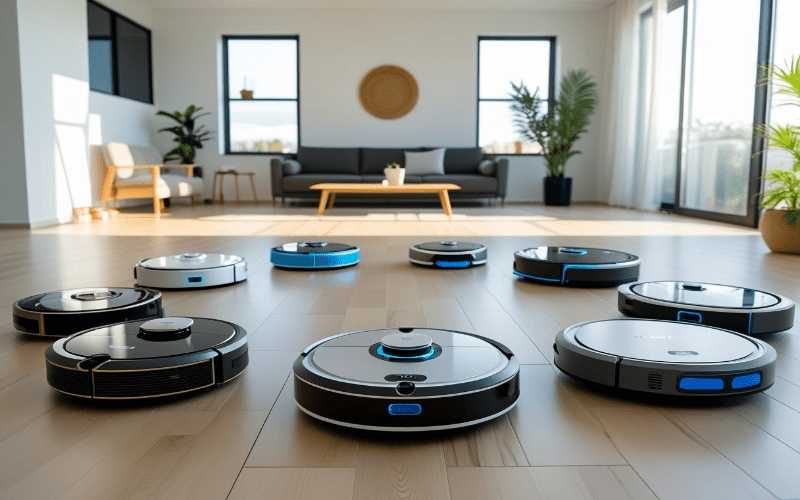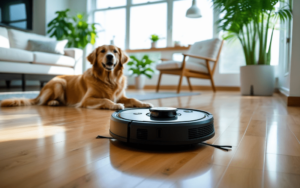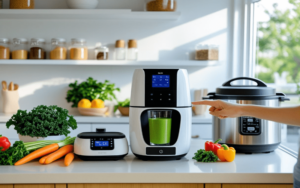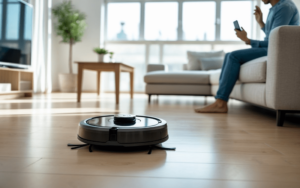Discover the 7 best robot vacuums in 2025 that do the dirty work for you. Tested for smart features, efficiency, and value.
Robot vacuums have really leveled up. In 2025, they’re smarter, more powerful, and honestly, just easier to deal with than ever.
The top 7 robot vacuums this year can handle cleaning your floors automatically, saving you both time and effort while keeping your home looking tidy.
These devices work on different kinds of flooring. They can even dodge furniture and random shoes without much trouble.
With features like self-emptying bins, strong suction, and even mopping, it’s no wonder so many people are switching to robotic cleaners. Models like the Roborock Saros 10R and Roborock Q5 Max+ are making waves for their performance and tech, as seen in reviews from ZDNET and Best Products.
This new crop of robot vacuums is loaded with smart features. Whether you’ve got carpet, wood, or tile, there’s something out there to handle the mess and take some stress off your plate.
Please note that this article contains affiliate links. We may earn from qualifying purchases at no extra cost to you.
Key Factors to Consider When Choosing a Robot Vacuum
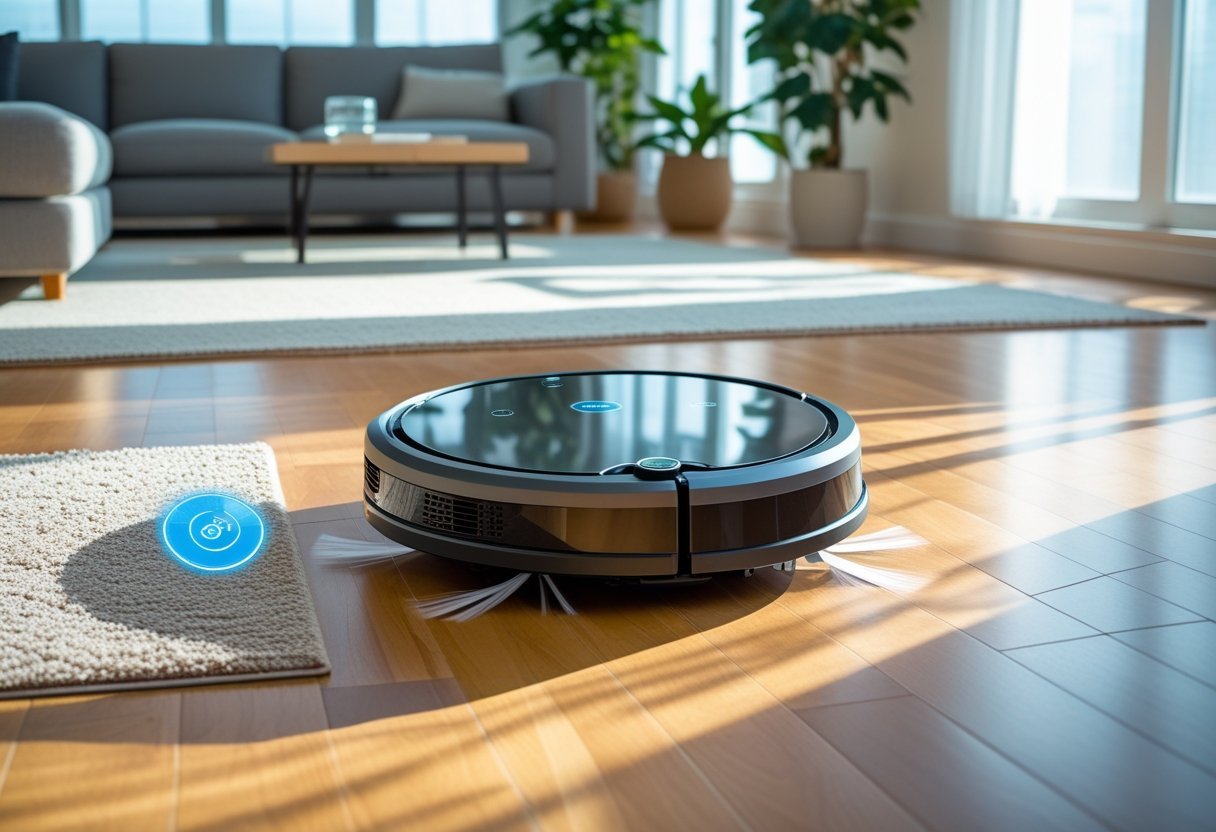
Robot vacuums now use smart sensors, new cleaning systems, and longer-lasting batteries. But what should you actually care about when you’re shopping?
Cleaning Performance and Power
The cleaning ability of a robot vacuum comes down to suction strength, brush design, and how it handles debris. High suction (measured in Pascals, or Pa) grabs dirt, pet hair, and dust from both hard floors and carpets.
Many top models can sense different floor types and adjust suction on the fly.
Main features to compare:
- Suction power (Pa rating)
- Multi-surface brushes
- Tangle-free rollers
- Dirt sensors
Some units, like the Roborock S8 Pro Ultra, use dual brushes and high suction for deep cleaning. Models with self-emptying docks mean less emptying for you, which is pretty great if you’ve got pets or a lot of daily mess. RTINGS.com notes the Roborock S8 Pro Ultra is especially good for heavy messes.
Navigation and Mapping Technology
Navigation is what separates the so-so robots from the really good ones. Basic models might just wander around, missing spots or bumping into things.
The best robot vacuums use smart mapping and sensors to clean in neat, efficient paths.
Look for:
- Optical or laser sensors (LiDAR)
- Obstacle detection
- Room mapping via app
- No-go zone setting
Advanced systems, like those in Roborock and Ecovacs models, use lasers and cameras to scan rooms and build maps. They dodge obstacles, rarely get stuck, and can remember more than one floor layout.
You can set up cleaning schedules by room, and some even change routes if you move the furniture. Handy, right?
Battery Life and Charging Efficiency
Battery life matters if you want a robot that covers your whole place in one go. Most vacuums need at least 90 minutes to handle a medium-sized home.
High-end models offer longer run times and smarter charging tricks.
Important aspects:
- Battery capacity (mAh)
- Auto-return to dock
- Fast charging support
- Ability to resume cleaning
The best robots know when to recharge and will head back to their dock before running out of juice. After charging, they pick up right where they left off.
Many modern vacuums, like the Roborock Q5 Max+, can handle big homes with fewer interruptions. Wirecutter highlights models with self-emptying docks that make the whole process even more hands-off.
Top 7 Robot Vacuums in 2025: Expert Selections
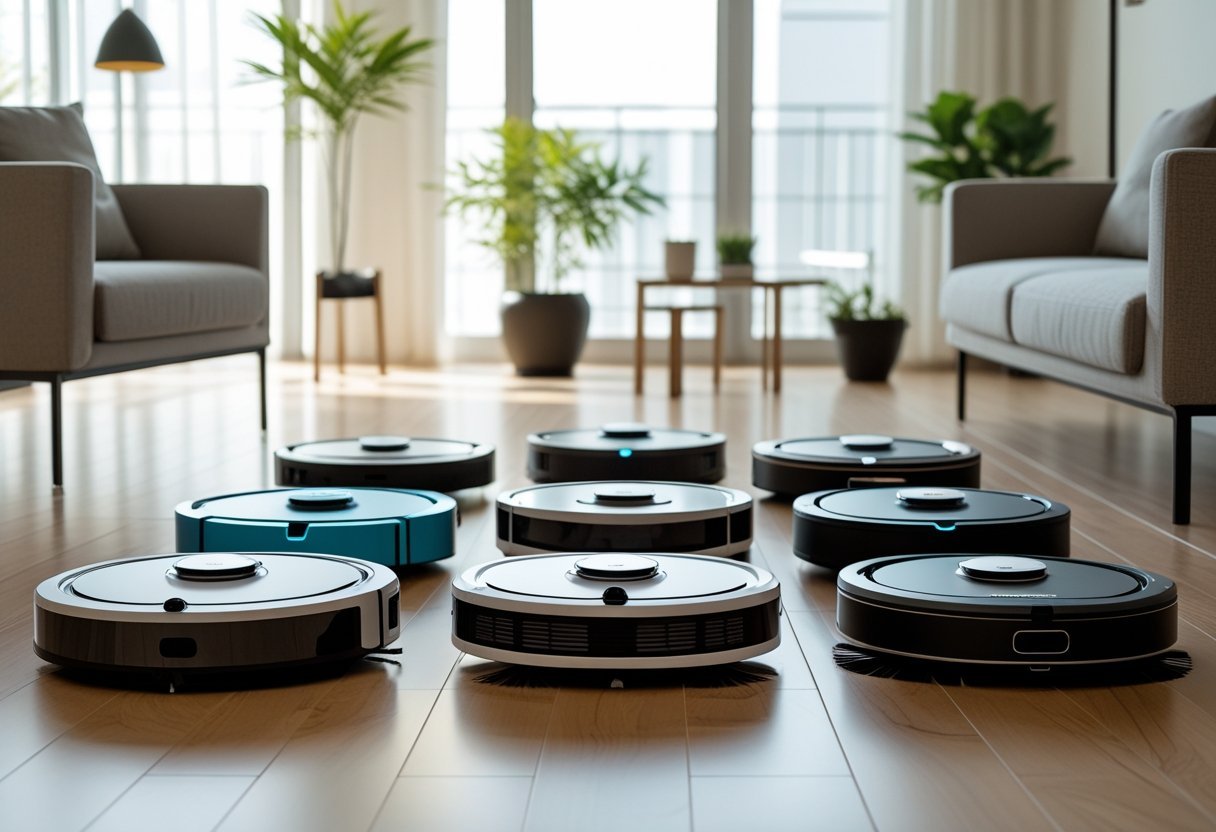
Robot vacuums in 2025 are cleaning better, navigating smarter, and automating more than ever. A lot of them can empty themselves, mop, and handle mixed floor types without much fuss.
Best Overall Robot Vacuum
The Shark PowerDetect 2-in-1 Robot Vacuum and Mop is a real standout this year. It vacuums and mops, empties its own dustbin, washes its mop, and even refills the water tank on its own.
If you want less maintenance and more convenience, it’s a solid choice.
It uses smart sensors to avoid obstacles and works well on both carpet and hard floors. The suction picks up most dirt, crumbs, and pet hair, and it connects to Wi-Fi and popular voice assistants for hands-free control.
Owners like that the PowerDetect 2-in-1 can cover big spaces without getting stuck. Expert testing confirms it’s reliable, simple to set up, and good for daily cleaning in most homes.
We may earn a small commission if you purchase through this link. Thank you for supporting our content!
Best Value for Money
The Yeedi M12+ Pro brings a bunch of premium features at a lower price than a lot of the competition. It adjusts suction for carpets and hard floors, dodges obstacles, and can mop and vacuum in one go.
This robot comes with a self-emptying base, so you don’t have to empty it every time. Its mapping tech helps it move efficiently, so it doesn’t miss any spots.
People like how quietly it runs and how much stuff it picks up per cleaning. If you want a good mix of features and price, the Yeedi M12+ Pro is a top pick among experts.
Best for Pet Hair Removal
The iRobot Roomba j7+ is a go-to for pet owners. Its strong suction and dual brush system are made to grab pet hair from carpets and hard floors alike.
The Roomba j7+ also uses smart obstacle detection, so it can avoid pet toys and, well, other pet messes. It has a self-emptying base, so you deal with less mess overall.
The brushes don’t tangle easily, which keeps things running smoothly. Folks with allergies or lots of shedding pets like the cleaner air and floors, and experts say the Roomba j7+ is great for pet hair and doesn’t get tripped up in busy rooms.
Smart Features and Automation Capabilities
Modern robot vacuums in 2025 do more than just vacuum. They hook up with smart devices, offer app control, and can even empty themselves to cut down on daily chores.
Voice Assistant Integration
Voice assistant integration means you can control your robot vacuum without lifting a finger. Most 2025 models work with Alexa, Google Assistant, or Siri, so you can start, pause, or send the robot home with just your voice.
It’s a lifesaver when your hands are full. Some vacuums, like the Ecovacs Deebot series, let you tweak cleaning settings or check cleaning progress through your smart speaker.
You can set up custom routines, so the robot cleans every morning automatically. Some devices can even tell which room you mean—say “clean the kitchen,” and off it goes to the right spot.
App Control and Scheduling
Most new models come with mobile apps that let you control your vacuum from anywhere. You can map your house, watch it clean in real time, or set up which rooms to clean on which days.
Apps let you draw virtual boundaries and keep tabs on cleaning progress. Higher-end robots, like those in the top 10 robot vacuums of 2025, can store maps for multiple floors, which is handy if you’ve got a bigger home.
You’ll get push notifications about finished jobs, low battery, or when the bin needs emptying. Some apps even let multiple people in the house control and track the vacuum—no more arguing over whose turn it is to clean.
Self-Emptying and Maintenance Systems
Self-emptying is a big deal in 2025’s robot vacuums. Many higher-end models now return to their base and dump debris into a bigger bin, so you don’t have to empty them as often.
Maintenance reminders pop up in the app, letting you know when it’s time to clean or swap out a filter, mop, or brush. Robots like the MONSGA can self-empty for up to 60 days, which is a huge time-saver for busy households.
Bags for the self-emptying base are easy to swap and keep dust contained. Some robots also have self-cleaning mop pads and brush rollers, so you don’t have to get your hands dirty untangling hair or wiping things off.
Here’s a quick table with some of these handy features:
| Feature | Benefit |
|---|---|
| Self-Empty Base | Less frequent bin emptying |
| Self-Cleaning Brushes | Prevents tangles, less upkeep |
| Maintenance Notifications | Timely filter and part care |
Robot Vacuums Performance on Different Floor Types
Robot vacuums in 2025 can handle pretty much all common floors. They use sensors and special brushes to adapt, though results can still vary depending on the model, your floors, and how messy things get.
Carpet and Rug Cleaning with Robot Vacuum
Modern robot vacuums use strong suction and multi-surface brushes to pull dirt from carpet fibers. Some, like the Roborock Q5 Max+, come with enhanced suction and a carpet boost mode that automatically increases power when moving onto carpets or area rugs.
The newest models can adjust brush height and suction to handle low-pile, medium-pile, and some thick rugs. They pick up pet hair and crumbs well, but might still have trouble with high-pile or shag carpets.
AI obstacle avoidance is a handy feature. It helps vacuums dodge furniture and avoid getting tangled on tassels or cords—something that’s honestly a relief if you’ve ever had to untangle a robot from a rug fringe.
Performance can drop on dark or patterned rugs, since some sensors just don’t “see” those surfaces well. If your home has mixed flooring, it’s worth seeking out vacuums that transition smoothly and can handle both hard and soft surfaces.
For best cleaning, the latest high-end units offer strong results on various types of carpet.
Hardwood and Tile Cleaning
On hard surfaces like hardwood or tile, robot vacuums use soft brushes and edge sensors to pick up fine dust, pet hair, and debris. Models such as the Shark PowerDetect 2-in-1 can even mop and vacuum in one go, which is pretty efficient for homes with lots of hard floors.
Most premium models come with smart mops that detect floor type and adjust moisture to prevent streaks or water damage. Roller mops and self-cleaning systems help keep floors polished and reduce the hassle of maintenance.
Edge-cleaning features matter if your home has lots of corners or baseboards. People with pets or allergies might want vacuums with HEPA filters and self-emptying bins, which reduce dust emissions during use.
Most 2025 models transition easily between hard surfaces and rugs. Still, it’s smart to check for models that stand out on hardwood and tile before buying.
Allergy and Health Considerations
Robot vacuums can help limit dust, pollen, and pet hair in the home. Their design—including filtration systems and dustbin size—matters for anyone with allergies or respiratory issues.
Robot Vacuums with HEPA Filtration
A HEPA (High-Efficiency Particulate Air) filter in a robot vacuum traps small particles like pollen, dander, and fine dust. This is essential for people with allergies or asthma, since it stops allergens from getting blown back into the room during cleaning.
Not all robot vacuums offer HEPA or true HEPA filters. Models with certified HEPA filters usually capture at least 99.97% of particles as small as 0.3 microns.
The Eufy G30+ Self-Emptying and similar vacuums are designed with allergy care in mind, making a real difference in homes with pets.
Cleaning and replacing HEPA filters on schedule is important. Clogged or old filters can’t trap particles effectively, which reduces the health benefits these vacuums offer.
Dustbin Capacity
A larger dustbin means the robot vacuum can collect more dirt, hair, and dust before you have to empty it. This is especially important in homes with pets or heavy dust—small bins fill up fast and can impact performance.
Some robot vacuums include self-emptying stations. These let the robot empty its bin into a larger container, so you don’t have to handle dust and allergens as often.
For people with allergies, less frequent emptying means less direct contact with dust. The iRobot Roomba Vac Essential and other models with larger or self-emptying systems are easier to maintain, especially in bigger homes.
Longevity, Durability, and Warranty
Robot vacuums need to stand up to daily wear and tear. Quality materials and strong support from the maker can really decide how long a vacuum sticks around.
Build Quality of Robot Vacuums
A robot vacuum’s build quality matters a lot for its lifespan. Models like the Roborock Q5 Max+ and iRobot Roomba j7+ use tough plastic and thoughtful engineering to handle bumps, drops, and long run times.
Premium models tend to have stronger wheels, reliable sensors, and well-protected motors. Cheaper vacuums sometimes use thinner plastic, which is more likely to crack or break after a run-in with furniture.
Higher-end vacuums often include brush guards, thicker bumpers, and improved filters. That helps them last longer and makes maintenance less of a headache.
Quick Facts Table
| Model | Frame Material | Bumper | Dust Bin Design |
|---|---|---|---|
| Roborock Q5 Max+ | Thick Plastic | Reinforced | Removable, Sealed |
| iRobot Roomba j7+ | Sturdy Plastic | Soft Edge | Large, Easy Empty |
| Eufy Clean E20 | Plastic | Light Foam | Small, Simple |
Buyers should check for flexible wheels, smooth sensors, and dust bins with tight seals to reduce wear and dust leaks.
Manufacturer Support
Warranty policies and customer support can make a difference for peace of mind. Brands like iRobot and Roborock usually offer at least a one-year limited warranty on major components, while some budget brands may only give you six months or less.
A clear, long warranty often means the brand stands by its build quality. Support matters too—leading companies provide spare parts, online troubleshooting guides, and quick shipping for repairs.
For example, iRobot Roomba j7+ models have easy access to replacement parts. Other brands may require sending the vacuum to an official service center, which is a hassle nobody wants.
Warranty Checklist:
- Length of coverage (1 year minimum is best)
- What is covered (motors, sensors, battery)
- Ease of accessing repairs/parts
- Reputation for responding to support requests
Checking warranty details before buying can help avoid future headaches and unexpected costs.
Cost of Ownership and Long-Term Value
The total cost of owning a robot vacuum isn’t just about the sticker price. Regular maintenance, replacement parts, accessories, and power use all play a part in long-term value.
Replacement Parts and Accessories
Robot vacuums need routine changes of brushes, filters, and sometimes wheels or sensors. These parts typically last a few months to a year, depending on how much you use the vacuum and what your home is like.
Most major brands like iRobot, Roborock, and Ecovacs make these parts easy to find and replace. Owners should watch for hidden costs such as proprietary bags or extra mopping pads, which can add up over time.
For vacuums with self-emptying docks, the collection bags need replacing every 1–2 months. Prices for basic replacement kits range from $20–$60, while specialty parts can be higher.
Buying accessories in combo packs often saves money compared to single purchases. Here’s a typical replacement schedule:
| Part | Replacement Period | Average Cost |
|---|---|---|
| Filter | Every 2–4 months | $10–$20 (2 pack) |
| Main Brush | 6–12 months | $12–$30 |
| Side Brush | 3–6 months | $8–$15 (2 pack) |
| Dust Bags | 1–2 months (dock) | $12–$30 (6 pack) |
We may earn a small commission if you purchase through this link. Thank you for supporting our content!
Energy Efficiency
Most robot vacuums are surprisingly energy efficient when you stack them up against standard upright vacuums. A typical robot vacuum uses just 30–60 watts per cleaning session, while uprights can easily top 1000 watts.
Actual energy use depends on things like suction mode, how long it runs, and whether the dock has extra features. If you’ve got a self-emptying base, that can bump up the power draw a bit when it empties the bin.
Newer models—think Roborock Q5 Max+ or Ecovacs X9 Pro Omni—often come with smart scheduling. They’ll only run when needed, which is a nice way to save a little more energy.
Most charge up in less than four hours. One charge is usually enough to clean an average-sized home, unless you live somewhere enormous.
Over time, power costs stay pretty low—usually under $15 per year for most people. If you’re trying to cut that down even more, you can schedule cleaning for off-peak hours or try out eco-modes. Those modes take a bit longer but sip electricity.
Find our best selection from Amazon pics here
Find our best selection from Ecovacs pics here
This article contains affiliate links, which means we may earn a commission if you purchase through our links, at no extra cost to you. As an Amazon Associate, we earn from qualifying purchases. Thank you for supporting our content!

